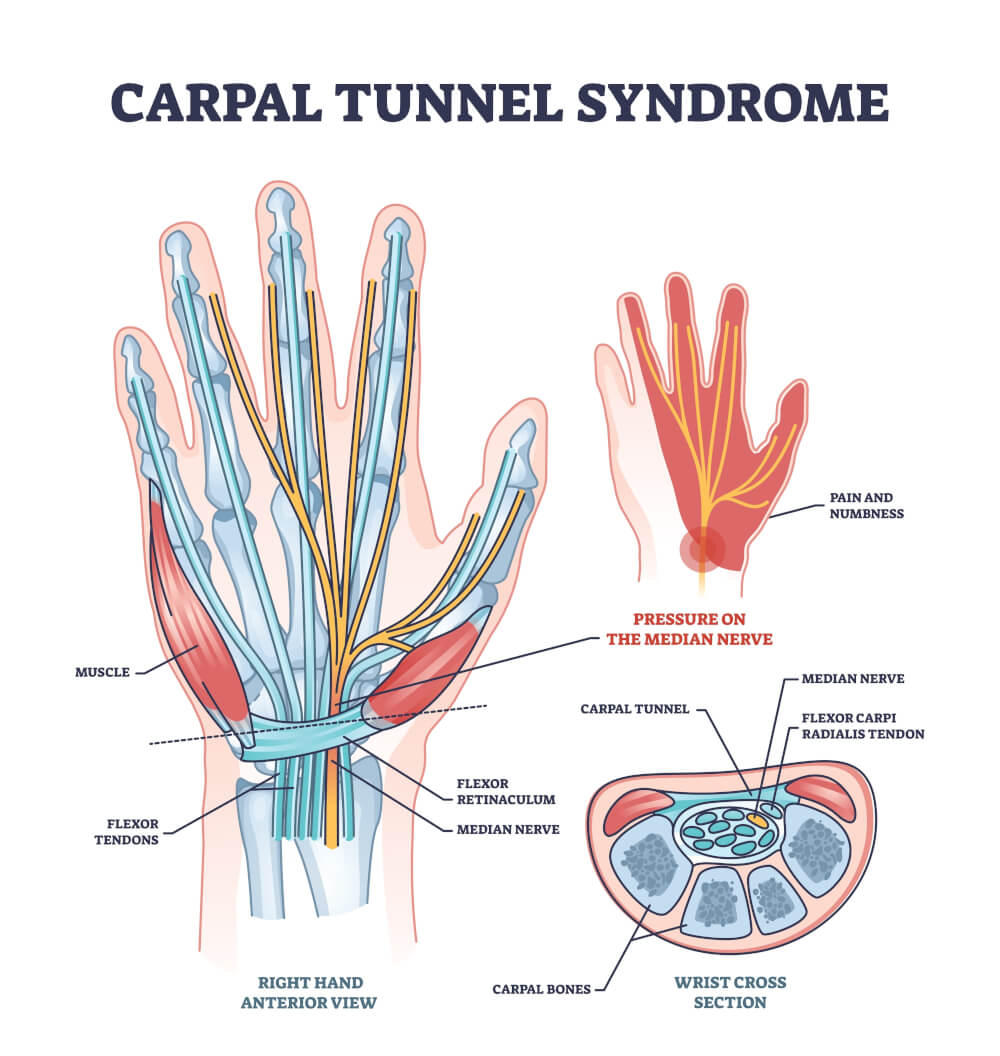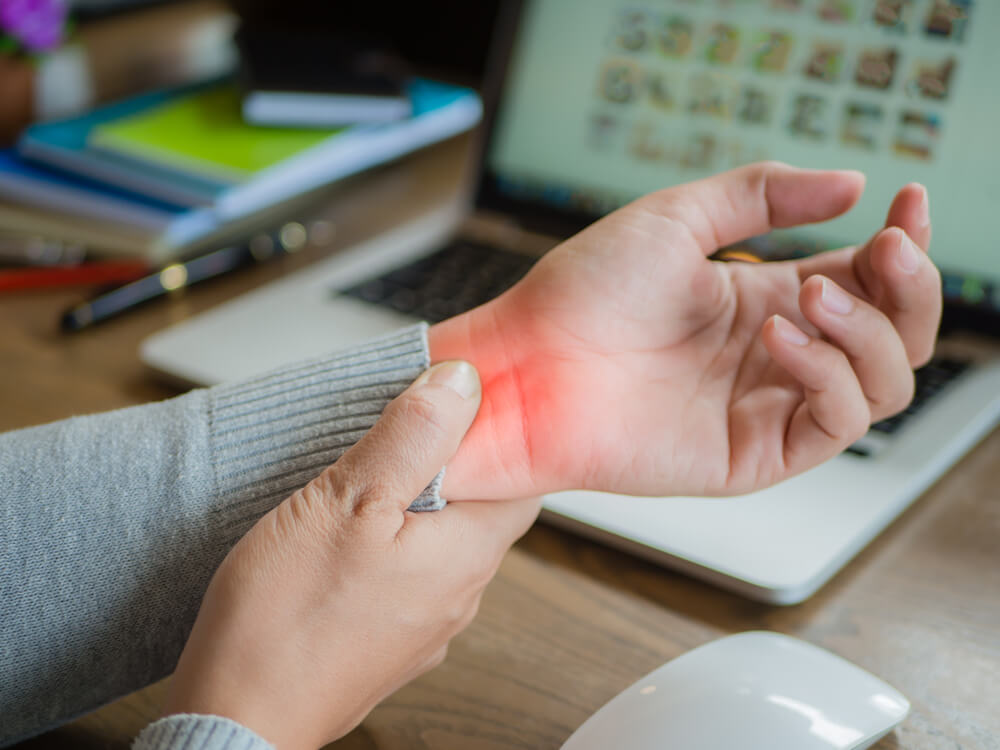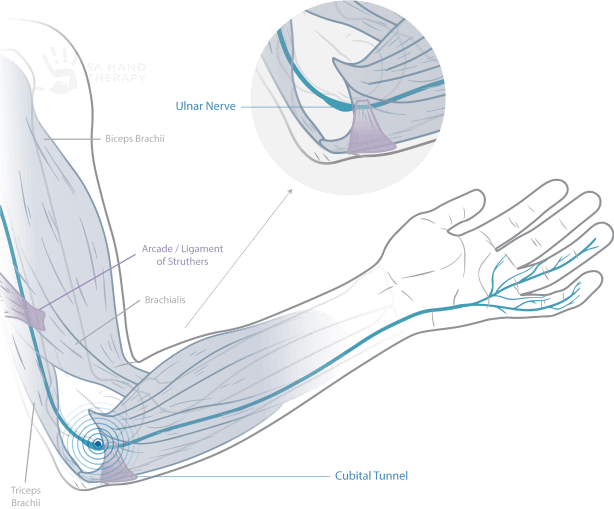Carpal Tunnel Syndrome
Home » Treatment » Hand & Wrist » Carpal Tunnel Syndrome
Carpal vs Cubital Tunnel Syndrome?
Carpal Tunnel Syndrome (CTS) and Cubital Tunnel Syndrome (CuTS) are distinct conditions that affect different areas of the upper extremities, specifically the hand and wrist in the case of CTS and the elbow in the case of CuTS. The primary difference lies in the location of the affected nerve and the corresponding symptoms.
If you have a question about whether your condition should be treated by one of our hand therapists, call Restored Hope Hand Therapy at (928) 275-2201.
What is Carpal Tunnel Syndrome?

Symptoms of CTS
The hallmark symptoms of Carpal Tunnel Syndrome include pain, numbness, and tingling in the thumb, index finger, middle finger, and part of the ring finger. These sensations often extend to the palm and may even radiate up the arm. Individuals with CTS may also experience weakness in the affected hand, making it challenging to grasp objects or perform fine motor tasks.
Causes & Diagnosing CTS
Several factors contribute to the development of Carpal Tunnel Syndrome. One primary cause is repetitive motion or overuse of the wrist, common in activities such as typing, using a computer mouse, or engaging in activities that involve constant hand and wrist movement. Other risk factors include obesity, pregnancy, diabetes, and certain medical conditions like rheumatoid arthritis.
Diagnosing Carpal Tunnel Syndrome typically involves a thorough examination by a healthcare professional. The medical history of the patient, including any underlying conditions or activities that may contribute to CTS, is carefully reviewed. Physical examinations, such as Tinel’s and Phalen’s tests, may be conducted to assess the presence of characteristic symptoms. Additionally, electromyography (EMG) and nerve conduction studies can help confirm the diagnosis by measuring the electrical activity of muscles and nerves.

Treating CTS in Prescott, AZ
The approach to treating Carpal Tunnel Syndrome at Restored Hope Hand Therapy varies depending on the severity of symptoms and individual factors. The following measures are often the first line of treatment at our Prescott, AZ clinic and may include:
- Personalized Exercise Programs: We design tailored exercise regimes to fortify the hand and wrist, enhancing flexibility and reducing symptoms.
- Ergonomic Assessments: We’ll offer ergonomic evaluations to rectify harmful work or lifestyle habits that may exacerbate CTS.
- Manual Therapy: Our hand therapists can provide manual therapy to alleviate stiffness and promote mobility.
- Splinting and Support: We are experts at creating custom-made splints to help maintain an ideal wrist position, alleviating pressure on the median nerve. Specifically, wearing a wrist splint at night can help keep the wrist in a neutral position, reducing pressure on the median nerve and alleviating symptoms.
- Education: We can equip you with the knowledge and strategies to manage and prevent future episodes of CTS.
For more severe cases or those that do not respond to the above measures, these interventions may be considered:
- Rest and Modification of Activities: Avoiding activities that exacerbate symptoms and taking regular breaks during repetitive tasks can help prevent further irritation of the median nerve.
- Anti-Inflammatory Medications: Nonsteroidal anti-inflammatory drugs (NSAIDs) may be recommended to reduce inflammation and relieve pain.
- Corticosteroid Injections: Injecting corticosteroids into the carpal tunnel can help reduce inflammation and provide temporary relief from symptoms.
- Surgery (Carpal Tunnel Release): In cases where conservative treatments are ineffective, surgical intervention may be recommended to relieve pressure on the median nerve. This involves cutting the ligament that forms the roof of the carpal tunnel, creating more space for the nerve.
Preventing CTS
While Carpal Tunnel Syndrome may not be entirely preventable, certain measures can reduce the risk of its development or recurrence:
- Ergonomic Workstations: Ensuring that workstations are ergonomically designed can help minimize strain on the wrists during repetitive tasks.
- Frequent Breaks: Taking regular breaks during activities that involve repetitive hand and wrist movement can prevent overuse and reduce the risk of CTS.
- Hand and Wrist Exercises: Performing regular exercises to strengthen and stretch the muscles in the hand and wrist can contribute to overall joint health.
What is Cubital Tunnel Syndrome (CuTS)?
Cubital Tunnel Syndrome (CuTS), also known as ulnar neuropathy, is a condition that involves compression or irritation of the ulnar nerve as it passes through the cubital tunnel, a narrow passageway on the inside of the elbow. The ulnar nerve is one of the three main nerves in the arm and is responsible for providing sensation to the little finger and part of the ring finger, as well as controlling certain muscles in the hand.
The cubital tunnel is formed by the bones, ligaments, and muscles on the inner side of the elbow. When the ulnar nerve becomes compressed or irritated within this tunnel, it can lead to various symptoms associated with Cubital Tunnel Syndrome.

Common Symptoms of Cubital Tunnel Syndrome
- Numbness and Tingling: Individuals with CuTS often experience numbness and tingling in the ring and little fingers. This sensation may come and go, and it may be more pronounced when the elbow is bent for an extended period, such as during activities like talking on the phone or sleeping with the elbow flexed.
- Weakness: Weakening of the grip or difficulty with fine motor skills in the affected hand can occur. This may lead to challenges in tasks that require precise finger movements.
- Pain: Some individuals with Cubital Tunnel Syndrome may experience pain on the inner side of the elbow. This pain can range from mild to severe and may be present both at rest and during certain movements.
Contributing Factors
- Repetitive Elbow Bending: Activities that involve repetitive bending of the elbow, such as prolonged phone use or leaning on the elbow for extended periods, can increase the risk.
- Pressure on the Elbow: Resting the elbow on hard surfaces or prolonged pressure on the elbow can compress the ulnar nerve.
- Anatomical Factors: Some individuals may have a predisposition to CuTS due to variations in the anatomy of the cubital tunnel or surrounding structures.

Treatment for Cubital Tunnel Syndrome
At Restored Hope, our hand therapists will assess your neural symptoms and provide advice regarding appropriate management options. We can assist with strategies to reduce pressure placed over the nerve at the elbow, such as appropriate splinting solutions for night and assistance with activity modification. We hold additional skills in manipulation techniques, taping, strengthening and exercises to assist neural movement and reduce neural irritation at the elbow.
Hand & Wrist Therapy Options
individualized-specific therapy programs to offer you the best possible results.
Hand & Wrist
- Arthritis
- Carpal & Cubital Tunnel Syndromes
- De Quervain's Tenosynovitis
- Dislocations
- Dupuytren's Contracture
- Flexor Tendon Injuries
- Fractures
- Ganglion Cyst
- Ligament Tears
- Mallet Finger
- Sprains & Strains
- Tendon Transfer Neuro Re-education
- Trigger Finger
- Wrist Sprain

